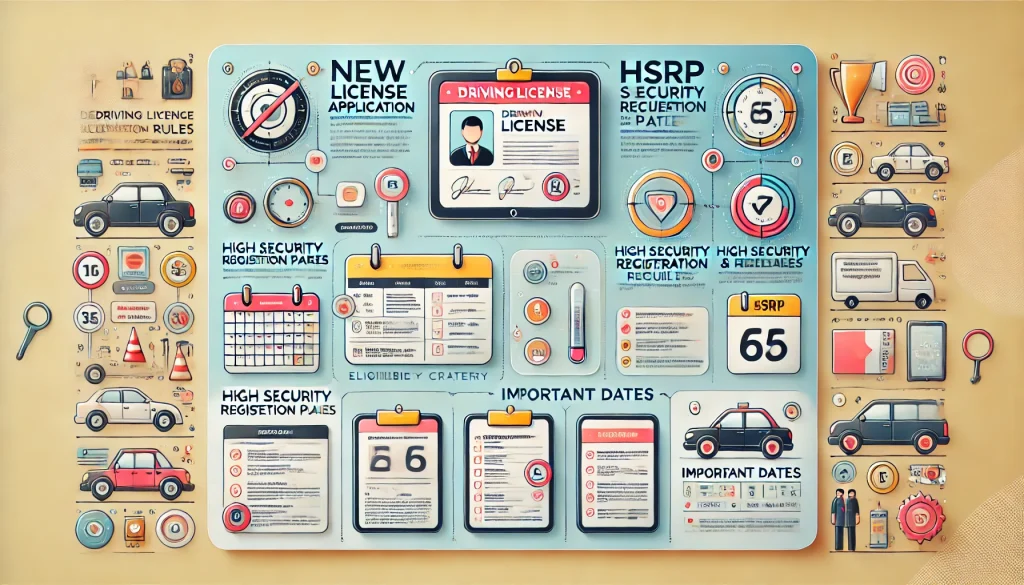Every year, the government implements new regulations for roads, motor vehicles, and driving. This has so far benefitted us by providing an ever-growing system with better infrastructure and road safety.
However, the main part is that everyone is aware of those changes and complies with them to avoid any form of penalty. This year, too, the government has implemented new rules for driving licenses, which have been discussed in this post.
New Rules for Driving Licenses in India 2024
Starting June 1, 2024, new rules for getting a driver’s license in India will be adopted, with the goal of simplifying the procedure and improving road safety. Here are the main changes:
- Private Driving Schools: Applicants can now take their driving exams at authorized private driving schools for learning licenses and permanent driving licenses rather than government Regional Transport Offices (RTOs).
- Documentation and Application Process: Applying for a driver’s license has been simplified. Applicants can submit their applications online through the Ministry of Road Transport and Highways portal, upload the essential documents, and pay the applicable costs. Physical documentation requirements have also been lowered.
- Penalties: Driving without a valid license can result in penalties of Rs.1,000—Rs.2,000. If a juvenile is detected driving, they will face a fine of 25,000, have their car registration revoked, and be prevented from acquiring a license until they are 25 years of age.
- Environmental Rules: To decrease pollution, the government will phase out some 900,000 outdated government cars and impose higher emission regulations.
- Fees: A learning license will cost Rs.150, with an extra Rs.50 for testing. The cost for applying for a driving license will be Rs.200, while for an international driving license, it will cost Rs.1000. Renewing a license after the grace period incurs extra fees.
- Training criteria for Driving Schools: Private driving schools must fulfill strict land and building criteria and deliver a standardized training program. Trainers require at least five years of driving experience and an understanding of biometric and IT systems.
These modifications are part of a larger attempt to improve road safety and make the licensing system more efficient. For further information, you may visit the Ministry of Road Transport and Highways’ official website.
India’s Continuation of Implementing HSRP
In 2024, India will continue to implement High-Security Registration Plates (HSRP) for all cars to improve security and standardize vehicle registration plates. Here are the essential aspects of the HSRP regulations and updates:
- Mandatory Compliance: HSRPs are required for all cars registered before April 1, 2019. This applies to both private and commercial automobiles.
- Online Registration procedure: The Ministry of Road Transport and Highways (MoRTH) has simplified the registration procedure by providing a single website (www.siam.in), where vehicle owners may buy HSRPs, select dealer locations, and arrange installation appointments. Payments can be made online, eliminating the need for cash.
- Security: Genuine HSRPs include various security measures, including a chromium hologram of the Ashoka Chakra, laser-etched codes, and retro-reflective characteristics, which improve visibility and prevent counterfeiting.
- Penalties for Noncompliance: Vehicles not fitted with HSRPs by the deadlines may face fines and other penalties. Vehicle owners should maintain compliance with regulations to avoid penalties.
- Awareness: State governments are increasing public awareness about the need for HSRPs and the procedure to get them, particularly in rural regions with poor compliance rates.
Why is it important to follow the New Driving Rules in India?
Following the new driving regulations in India is crucial for various reasons, primarily to improve road safety, ensure compliance with legal requirements, and increase road transport efficiency. Here’s an in-depth look at why following these guidelines is important:
- For Road Safety: New restrictions, such as strict fines for noncompliance and the required use of High-Security Registration Plates (HSRPs), are intended to prevent traffic accidents and fatalities.
- Legalities: Noncompliance with the new standards may result in significant penalties and other legal repercussions. For example, driving without a valid license or neglecting to renew car registration with HSRPs might result in hefty penalties.
- Environmental Perks: Strict emission requirements reduce vehicular pollution, leading to cleaner air and a healthier environment. By conducting vehicle fitness checks for automobiles, the RTOs ensure that only the vehicles meeting the safety standards are allowed on the road, decreasing the environmental effect of badly maintained vehicles.
- Economical Impact: While early expenses may be involved with compliance (e.g., getting HSRPs or updating documents), following the standards can result in long-term savings by avoiding penalties and assuring higher fuel economy and cheaper maintenance costs through regular vehicle care.
- Security: HSRPs have security elements that make locating and recovering stolen cars simpler. This gives an extra degree of security for car owners and assists law enforcement in preserving road safety.
Conclusion:
What is worth more than human life, right? That is why the government is always setting up new rules and regulations regarding road safety in the country. We hope you got the idea of all the new rules and regulations revolving around the new driving rules in 2024.







